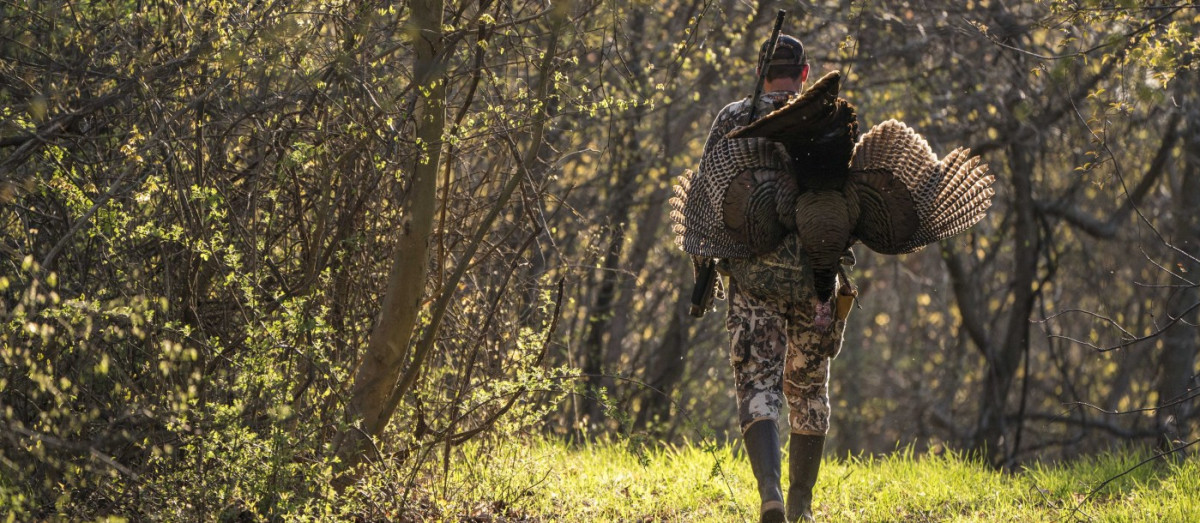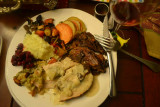
After a long winter, spring gobbler season is the hunting equivalent of spring break for college students. It is a great cure for cabin fever and offers hunters a nice change of pace from eating venison for several months. A single wild turkey can provide several meals and can be prepared using a wide variety of cooking styles. This is especially true if you’re willing to use every part of your turkey. Don’t be the lazy hunter who only pulls the breast meat. In some states, wanton waste laws make it illegal to do so, but more importantly, you’ll be missing out on some great meals.
Here are some of our favorite MeatEater recipes to try out after you bag your bird:
Whole and Half Birds
Plucking a turkey is well worth the effort if you plan on cooking a whole bird. We also like to halve plucked turkeys by splitting them down the backbone and through the middle of the breast. This allows for different preparations and makes transporting and storing your bird easier. Wild turkeys aren’t as fat or moist as domestic birds so it’s important to keep the skin on whole and half birds to prevent them from drying out during cooking.
- Oven Roasted Turkey This is the classic preparation for a Thanksgiving style meal. You can use a whole or half bird. Brine the bird for a day or so in a simple solution of water, salt, and sugar. This adds moisture to the meat. Stuffing the carcass also helps prevent a dry bird. Coat with oil and season with salt and pepper. Cover and roast over a bed of vegetables and a quart of game stock or water at 350 degrees. Baste frequently. Use the drippings and stock to make gravy. Serve with root vegetables and a slice of apple pie.
- Brined and Smoked Turkey This may be our favorite preparation for wild turkey. It’s light and sweet but at the same time it’s got a deep but subtle smoky flavor. Brining helps keep the meat moist while the bird smokes. You can use just a single breast, a half turkey, or a whole bird.
- Turkey Galantine If you really want to go all out and impress your dinner guests with a fancy wild game meal, this is the way to go. It’s labor intensive and it takes time but it’s a unique presentation that takes wild game cooking to the next level.
- Breast: Turkey breasts are the tenderloins and backstraps of the turkey world. There’s no such thing as a turkey breast that tastes bad. And they make a great introductory meal for someone who is new to eating wild game.
- Rolled and Stuffed Turkey Breast You’ll need to save the turkey skin to wrap up the breast for this preparation. Butterfly the breast out into a half-inch thick piece of meat. Spread a layer of simple stuffing on the meat. Try a mix of moistened coarse bread crumbs, apple chunks, chopped thyme and rosemary, wild game breakfast sausage, and morel mushrooms. Roll up the breast into a tight cylinder, wrap with the skin, then tie into a bundle with butcher’s twine. Season the skin with salt, pepper, and olive oil. Grill or bake in the oven at 350 degrees until internal temperature reaches 160 degrees. Rest for ten minutes and serve.
- Fried Turkey Nuggets This is a timeless crowd pleaser that will win over the pickiest eaters, including kids. Chop your breast meat into one to two-inch chunks. Soak in buttermilk for a few hours. Dredge in flour, then in an egg wash, then in panko crumbs. Deep fry in 375-degree peanut oil. Serve with a couple dipping sauces and cold beer.
- Schnitzel is the grown-up version of turkey nuggets. Serve it with a green salad and white wine and you’ve got yourself a restaurant-worthy meal.
- Legs and Wings: Turkey legs and wings are an underutilized afterthought for many hunters but the thighs are full of flavor and the amount of tender, light meat on the wings will surprise you. Wild turkey drumsticks are stringy and full of tendons but even this tough piece of meat can make for good eating if you know what to do with them.
- Barbecued Turkey Thighs Wild turkey thighs are a substantial piece of meat and they taste fantastic grilled and glazed in barbecue sauce. Brine the bone-in thighs overnight. Grill over low indirect heat until the internal juices run clear. Move to direct heat. Glaze the thighs in your favorite barbecue sauce until you have some char and caramelization. Serve with coleslaw.
- Street Tacos This is one of my favorite recipes for turkey legs and wings. The slow-cooking breaks down the connective tissue and tough meat and frying adds a crispy, caramelized texture. It’s a nice, light meal that’s ideal for a spring or summer dinner.
Giblets
The edible organs from a turkey are definitely worth keeping. They make a nice camp appetizer after a long day in the turkey woods.
- Pickled Giblets Save your turkey giblets and freeze them in water in a plastic container. As you add giblets add a layer of water and freeze again. When you have around a pound of hearts and gizzards (livers don’t freeze well) from turkeys, upland birds, waterfowl, and small game, it’s time to make pickled giblets. They make for a great hunting camp snack.
- Fried Liver- Fried turkey livers are a tasty snack while you’re butchering your bird. Coat in flour and fry in bacon grease.
Carcass and Neck
Don’t toss your bony turkey carcass after you’ve butchered your bird. You can also save the neck if it’s not too shot up. Using the carcass and neck allows you to get even more meals out of your gobbler.
- Wild Game Stock With the carcass and neck, you can make several quarts of turkey stock or some concentrated demi-glace with this simple recipe. Use the stock for making soups, stews, and braising tough cuts of meat.
- Turkey Noodle Soup Use your turkey carcass, neck, and whatever leftover turkey meat you have on hand to make a hearty soup. This is also a good use for the leg or wing meat.
Wild turkeys are fun and challenging to hunt and they’re also delicious critters that offer wild game chefs a wide array of cooking opportunities. When a gobbler sounds off just over the hill, those early morning rise times and long spring days in the woods will be well worth the effort when it’s time for a trophy meal.




Conversation